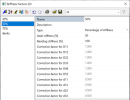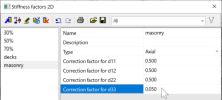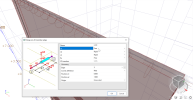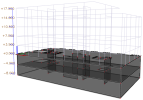Modelization for seismic analysis - Good practices
- use property modifiers - explain bending/in-plan stiffness for 2D members
- hinges on supporting members
- definition of masses: include only relevant masses in the model - split load cases above/below support level
A separate model for seismic analysis?
When a good 3D model of a structure is ready and has been extensively used for static analysis and design, it is tempting to use the same model for seismic analysis and design.
However, a number of assumptions used for static analysis are not always compatible with seismic analysis. Moreover, cases exist, where a completely different model might be more adapted for seismic analysis. For instance, it is common to remove from the model all underground levels that are irrelevant for seismic design. In such cases, using a separate model for seismic design can be the best option.
Do hesitate to consider saving a copy of the model and making the necessary changes for seismic analysis.
Please note: " Model modifiers" allow modifying the stiffness and absences of structural members for specific load cases in a project, but that feature is currently not supported for seismic load cases.
Use property modifiers
Reducing the stiffness of concrete and masonry shear walls is typically required to take into account the effect of cracking on the eigenfrequencies of the structure.
That can be achieved by creating modified materials with reduced properties (Young and Poisson modulus).
A more straight forward approach is using "Property modifiers for 1D and 2D members". Those allow altering the stiffness of 1D and 2D members without changing materials.
Stiffness changes can be applied by means of simple correction coefficients that multiply the stiffness components of the specified members.
- use the type Percentage of stiffness
- for 2D members, the relevant value is Axial stiffness, as it is typically the in-plane behaviour that is relevant for shear walls
- for masonry 2D members, additionally, it might be interesting to use the type Axial and reduce even more the shear stiffness component d33
Apply hinges on supporting members
Walls - and shear walls - are usually designed mostly against in-plane behaviour. Out-of-plane behaviour is considered locally, but not used for the overall behaviour of the structure. It is therefore often reasonable to remove that contribution from the model by inserting hinges at the top and bottom edges of all walls (for each storey). The same can be applied to all columns in structures where the shear resisting system is not based on frames.
Additionally, for masonry walls, it is possible to free the ux degree of freedom at the top edge of each wall to allow the deck to slide on the wall (unless the shear stiffness component of the masonry walls has already been reduced - see above).
Applying appropriate hinges on supporting members eliminates parasite, out-of-plane stiffness of supporting members and related internal forces from the results.
Define only relevant masses
Removing underground levels from the model for seismic analysis is a common approach. It makes the model lighter and removes all unnecessary, immobilized masses from the calculation.
However, keeping those levels in the model can be interesting, for instance to take into account the effect of their flexibility on the eigenfrequency of the system or to obtain results in the walls of the lower levels under seismic action for design purposes. Lower levels are often much more rigid that the rest of the structure, as they are typically a "closed box", practically a rigid body in comparison with the upper part of the building. As a consequence, the masses located in the underground levels are immobilized and eigen modes that would mobilize those masses are irrelevant for the seismic analysis.
Not only the stiffness of the lower levels is very high, but also their mass is significant (less openings in decks, more & longer walls...). In the example above, the two underground levels represent ~40% of the total mass of the building. That usually causes a significant deficit of effective modal mass, making it impossible to reach the required 90% of cumulated effective modal mass ratio.
It is recommended in such a case to remove immobilized masses from the model.
For self-mass, use "Property modifiers for 1D and 2D members": a separate coefficient allows to alter the mass of a member without affecting its self-weight (thus keeping intact the self-weight load case).
For mass groups linked to load cases with automatic update of masses, make sure to split load cases that span both upper and lower levels of the building (e.g. dead load). Create linked mass groups only for load cases applied on the upper levels.
For manually defined masses, just define masses only in the upper levels.
Removing masses from immobilized storeys plays a significant part in reaching the required 90% of effective modal mass ratio.







